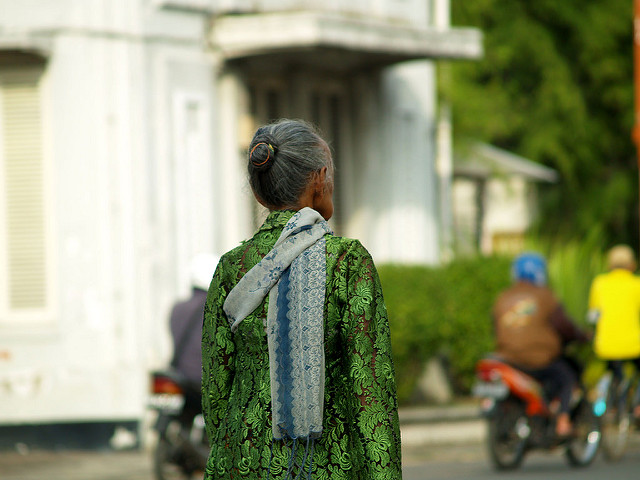Indonesia’s welfare schemes are failing to support older citizens
Indonesia’s welfare schemes are failing to support older citizens
‘Nek’ (Granny) Bibah, 70, is a widow living in a village in Lampung, the third poorest province in Western Indonesia, after Aceh and Bengkulu. She lives with her son, Yunus, 34, his wife and their child in the family home. Nek Bibah has no education and has always worked in her family’s rice field. As she can no longer work due to her poor health, Yunus and his wife now continue the family’s business.
Nek Bibah earns no income. Her family is entitled to, and regularly buys, raskin (beras miskin – subsidised rice for the poor), organised by the village head. She sometimes receives donations from her community, particularly during Ramadhan, the Muslim fasting month. The family does not have a BPJS (public health care) card, and Nek Bibah receives no other assistance from the government.
Nek Bibah’s experience is a common story among older people living in poverty in Indonesia.
An ageing population
At the beginning of this century, the Indonesian population started to age. In 2000, seven per cent of Indonesians (14 million people) were aged 60 years or older. In 2014, that group had increased to 20 million (eight per cent of the population) and is expected to increase almost fourfold by 2035, to 71 million people, or 14 per cent of the population.
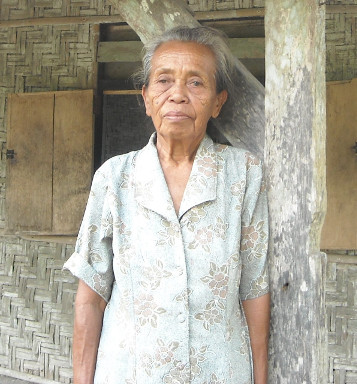 |
|
|
Nek Bibah at her home in Lampung, Sumatra. (Safrina Thristiawati) |
As in other ageing populations worldwide, there are more older women than older men in Indonesia. This is largely the result of two factors. Firstly, biology: as women have greater longevity, the proportion of older women increases with age. Secondly, men tend to be more involved in risky lifestyle behaviours, such as smoking, drinking and working in hazardous conditions, and are therefore more likely to die at a younger age.
The major demographic determinants of population ageing in Indonesia are the declines in both the number of deaths and the number of children born. Hence, there are proportionately fewer young people in the population and a higher proportion of older people. In addition, Indonesia has been experiencing increased domestic migration, particularly younger rural residents migrating to urban areas. This age-selective migration is likely to raise the average age in some provinces, particularly in rural areas. Consequently, different stages of population ageing occur across provinces and urban-rural locations. In 2010, the proportion of older people was the lowest in Papua, at two per cent, and the highest in Yogyakarta at 13 per cent.
Falling into poverty
In 2012, the SUSENAS (National Economic and Welfare Survey) results showed that poverty among older people was only slightly higher than overall poverty: 13 per cent compared with 12 per cent, respectively. The findings suggest that in 2012, about 2.5 million older people were considered ‘poor’ in Indonesia. People aged 70 and above have the highest poverty rate of all, at 15 per cent. Nevertheless, it is important to note that these figures are underestimated, because a much larger proportion (26 per cent, or around five million older people) are not officially classified as ‘poor’, yet are vulnerable to socio-economic shocks, and to falling into poverty.
Older people fall into poverty at varying rates. Older women outnumber older men in all but four provinces in Indonesia (Kalimantan Tengah, Kalimantan Timur, Papua and Papua Barat). The financial and social security of women and men in their old age is connected to their current and previous participation in the labour market. Gender differences in socio-economic status are partially rooted in the assumption that men hold the primary responsibility for paid work and women for unpaid housework and family care. This impacts on men’s and women’s abilities to accumulate social security entitlements for their older age.
Poverty rates also differ significantly across provinces and by urban-rural location. Poverty among older people in rural areas is about three per cent lower than that of the overall population. Cultural habits, earning possibilities, family structures and regionally specific migration patterns may help to explain the provincial and urban-rural variations.
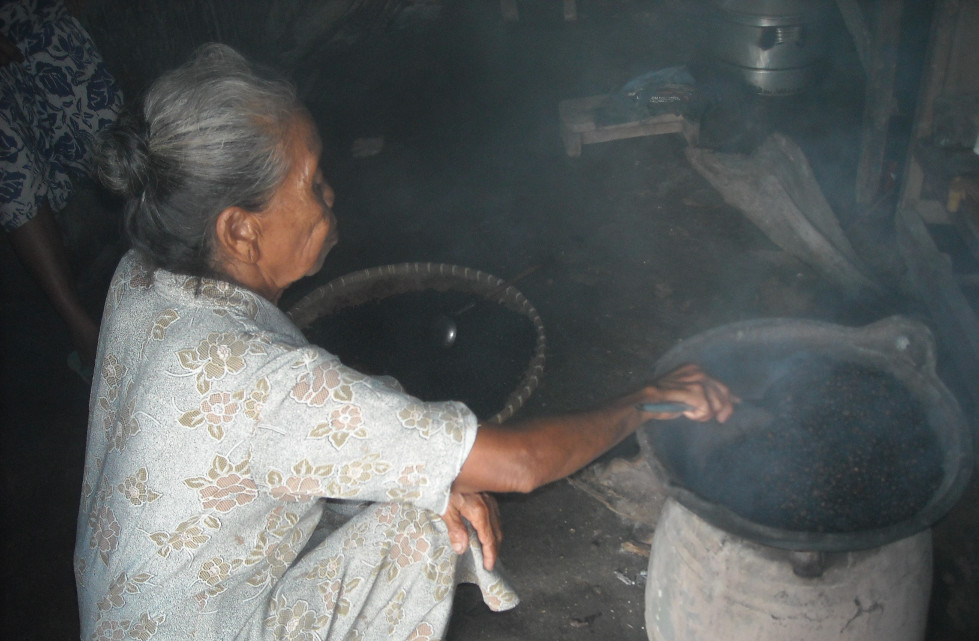 |
|
Nek Bibah, roasting coffee for her family. (Safrina Thristiawati) |
Pension programs
There are four main forms of social protection available to older people in Indonesia: (1) social security or contributory pensions; (2) government-funded social pensions or cash transfers paid on the basis of eligibility criteria, such as age and income; (3) income support or employment schemes; and (4) health insurance.
Indonesia currently does not have any universal pension programs. At present, older people who receive a pension are mostly those who previously worked in formal employment – as public servants, military personnel or employees in medium-to-large commercial enterprises – and/or their dependants. In 2010, only 16 per cent of older persons received this type of pension.
Since January 2014, in keeping with the Sistem Jaminan Sosial Nasional (SJSN – National Social Security System) 2004 Law, Indonesia has employed a multi-pillar approach to providing income support for those in their old age. The current reforms, based on the SJSN 2004 Law, are aimed at providing pensions for future older people – that is, adults who are currently working, who will retire in the next two to four decades.
Another type of pension is a social pension (or old-age grant), which is rarely available for older people living in poverty. This is because the government only sets aside a small number of social pensions, for select people. The existing social pension is ASLUT (Social Assistance for Older Persons). Launched in 2006 across six provinces, ASLUT provided a monthly pension of Rp.300,000 (approx. A$40) to 2500 beneficiaries. In 2013, it was expanded to all 34 provinces and the number of recipients was increased to 26,500, but with a reduced monthly pension of Rp.200,000.
ASLUT is relatively effective at targeting poor and neglected older persons. It predominantly reaches women aged 70 and above who are living alone, assisting them with their basic needs. However, it only reaches 0.6 per cent of poor older people. So far, the government is reluctant to improve this program or to increase funding for alleviating old-age poverty, resulting in a significantly high poverty rate among older people.
Alleviating poverty
In the 2015-2019 National Medium Term Development Plan, BAPPENAS (the National Development Planning Agency) plans to lower the overall poverty rate to 6.5 to 8 per cent by 2019. In order to achieve this target, it will be important to increase social protection for older people, particularly those living in poverty.
Poverty-targeted social pensions perform well in terms of poverty reduction versus cost ratio, as seen in other developing countries, such as Thailand, Vietnam and India. World Bank research in Thailand shows that social pensions appear to be an effective tool for reducing poverty among older Thais. In Vietnam, social security benefits (pensions and allowances for sickness, job loss and social welfare) do not impact poverty at the official poverty line, but they do help reduce vulnerability to poverty.
However, there are several disadvantages associated with poverty-based targeting of older people. Firstly, sometimes eligible candidates are not targeted (an error of exclusion), while ineligible candidates are included (an error of inclusion). Secondly, the cost of gathering and managing the data required for identifying beneficiaries, as well as the administrative costs involved, are high. Thirdly, there is a social cost to such programs. Some may not want to be stigmatised as ‘poor’ or as ‘program beneficiaries’ and may therefore choose not to participate in the program.
Nonetheless, poverty-targeted social pension schemes have been shown to be fiscally affordable and effective in reducing poverty. A working paper of the TNP2K (National Team for the Acceleration of Poverty Reduction) in 2012 showed that poverty-targeted cash transfers of Rp.200,000 per month, if correctly targeted at poor people aged 60 or over, are estimated to reduce poverty among older people from 12 per cent down to three per cent.
Indonesia has the capacity to develop effective poverty-targeted pensions across the board. Improving social pensions will dramatically reduce the number of older Indonesians living in poverty, and ensure that Indonesia is meeting its social welfare obligations to its older citizens.
Names have been changed.
Safrina Thristiawati (evisafrina@yahoo.com.au) holds a PhD in Demography and Sociology from the Australian National University. Her research focuses on the socio-cultural dimensions of health and well-being of older people.
Related articles from the archive
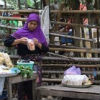 |
Aug 30, 2009 |
|
 |
Jan 09, 2011 |
|
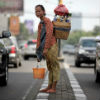 |
Feb 08, 2015 |

